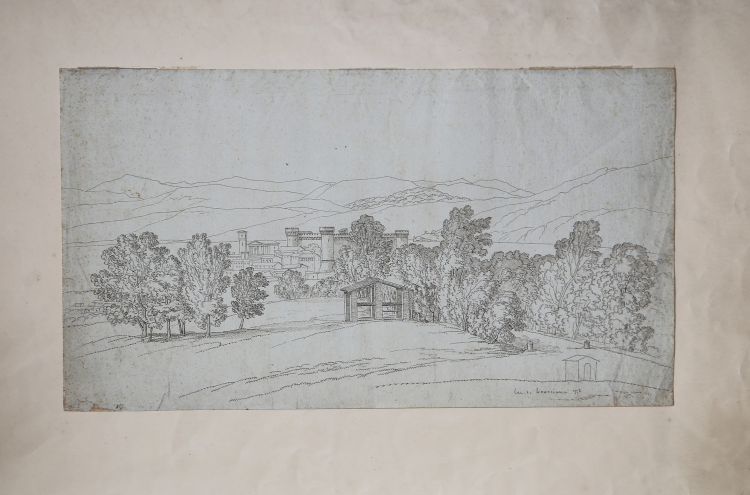



| Reference: | S40645 |
| Author | Andrè Giroux |
| Year: | 1825 ca. |
| Zone: | Bracciano |
| Measures: | 510 x 285 mm |


| Reference: | S40645 |
| Author | Andrè Giroux |
| Year: | 1825 ca. |
| Zone: | Bracciano |
| Measures: | 510 x 285 mm |
Pencil and ink drawing on contemporary blue laid paper, signed on verso André Giroux. In the lower right corner the title in pencil lac du bracciano.
The work depicts the lake and the town of Bracciano, with the Odescalchi castle in the foreground, and is related to the early period of the artist, during his trip to Italy between 1825 and 1830.
André Giroux was born in Paris in 1801. He had begun his studies with his father, a minor history painter, and made his debut at the Salon of 1819 when only eighteen years old. His earliest exhibits were urban genre scenes, but starting in 1822 he also submitted landscape studies from nature. In 1825 his competition entry on the subject of the Hunt of Meleager was awarded the Rome Prize for Historical Landscape, despite the fact that, unaffiliated with any of the leading academic teachers, Giroux had no influential backers. His fellow students at the Ecole des Beaux-Arts, members of the rising romantic generation that scorned classical landscape, used the award ceremony to stage a noisy protest. The scene was witnessed by Amaury-Duval, a pupil of Ingres, who recalled in his memoirs that the Rome Prize laureate fled sobbing into his father's arms, pursued by the jeers of the audience.
During his long stay in Italy (1825-1830), Giroux became associated with a group of young landscape painters that included Edouard Bertin (1797-1871), Théodore-Caruelle d'Aligny (1798-1871), and Léon Fleury (1804-1858), and made the acquaintance of Camille Corot (1796-1875), to whose landscape studies painted in the environs of Rome Giroux' own open-air sketches bear some resemblance. Like Corot, he sent a composed Italian landscape to the Salon of 1827 but at the same time submitted his more spontaneous studies tainted from nature in the Roman Campagna. His View of Casa Prota in the Sabine Hills won a gold medal at the Salon of 1831. Thereafter he continued as a regular exhibitor at the Salon until 1874, concentrating during the 1830s and 1840s on Italian subjects composed in the studio with the help of naturalistically observed detail studies gathered out-of-doors. In his later years, Giroux reverted to French landscapes and, having made the transition from Arcadian classicism to naturalism in Italian settings, ventured further toward modernity with paintings of industrial sites.
Small defects to the lower left corner, light oxidation, otherwise in good condition. Applied to the upper corners on nineteenth-century paper, probably belonging to an old collection.
Andrè Giroux Parigi 1801 - 1879
|
André Giroux was born in Paris in 1801. By the time the Paris-based painter André Giroux won the Prix de Rome for historical landscape painting in 1825, he had already been exhibiting his composed, classical landscapes at the Salon for several years. In Rome, where he remained until 1830, he made friends with the young and innovative landscape painters living in the city, including Corot, Edouard Bertin and Léon Fleury. He frequently painted and sketched out of doors with them. Giroux sent many of his oil sketches back to Paris, where one such series of Italian studies won him a first-class medal at the Salon of 1831.
|
Andrè Giroux Parigi 1801 - 1879
|
André Giroux was born in Paris in 1801. By the time the Paris-based painter André Giroux won the Prix de Rome for historical landscape painting in 1825, he had already been exhibiting his composed, classical landscapes at the Salon for several years. In Rome, where he remained until 1830, he made friends with the young and innovative landscape painters living in the city, including Corot, Edouard Bertin and Léon Fleury. He frequently painted and sketched out of doors with them. Giroux sent many of his oil sketches back to Paris, where one such series of Italian studies won him a first-class medal at the Salon of 1831.
|